#Rescue - Newcastle RNLI was involved in the rescue of three yachts in Strangford Lough during Storm Ali on Wednesday (19 September).
The lifeboat volunteers were first alerted at 11.40am to go the aid of a stricken yacht at Newtownards Sailing Club in Co Down.
As the all-weather lifeboat launched, under coxswain William Chambers, it quickly became apparent the challenging weather conditions the crew would face on their passage to Newtownards.
The main water tight doors were closed and all crew seated as they faced eight-metre waves hitting from the side.
A Force 8 gale was blowing as the crew approached Strangford Lough. It was some 90 minutes later before the seas started to settle as the lifeboat was sheltered by the shore.
On arrival at Newtownards at 2.15pm, the coastguard was concerned that there may be a person onboard the weather-beaten yacht, Newcastle RNLI confirmed that nobody had been on the boat and she was safely on the mooring.
The lifeboat was then requested to go the aid of another yacht drifting across the lough from White Rock and Kircubbin, but unfortunately by the time the volunteers reached the vessel there was nothing they could do as it was on the rocks on an ebbing tide.
On return to station, approaching Portaferry, the crew were alerted to a third yacht in difficulty. The crew established a tow line and managed to free the vessel and towed it to the safety off a mooring in Strangford.
Leaving the sheltered waters of Strangford Lough, the lifeboat and its crew once again faced mountainous seas and the coxswain decided to stop in Ardglass Marina for an hour to let the wind decrease and the wave size drop.
Leaving Ardglass around 6pm, the crew faced large but bearable seas, making it back to Newcastle an hour later.
“This was a challenging day for our volunteers given that we launched into rough seas when Storm Ali was at its worst,” said Chambers of the seven-hour shout.
“It was also uncertain at that point if there was a life at risk onboard the yacht. Thankfully there wasn’t in this case.
“It was a long and challenging day but our volunteers are highly skilled and trained for these situations and were delighted to be able to help.”































































